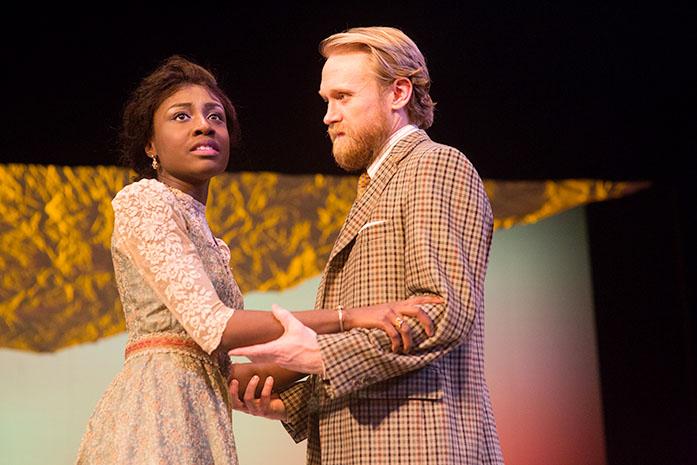Henrik Ibsen’s Lady from the Sea will take center stage in Mabie Theater.
By Tessa Solomon
[email protected]
The word “mermaid” roughly means “lady from the sea.” Whispering neighbors give the designation to the young bride Ellida, a figure always waiting by a fjord’s peak. Both yearning for and confined by a lover who left for the sea, she watches the still water as her husband waits at home.
These themes — confinement, obsession, and liberation — are explored in the UI Mainstage production of Lady From the Sea, written by Henrik Ibsen and directed by Nina Morrison.
It follows Ellida Wangel, a Norwegian woman raised along the sea’s wild and unpredictable waves. Her relocation to life along a fjord, a still harbor of water, ushers in an unwelcome change, reinforced by her unwilling marriage to Dr. Wangel. She searches for purpose in this new life while still yearning for a shadowy sailor, a long departed lover who promises his return through fervent letters.
“When I first read the story I didn’t like the character of Ellida,” said Emelia Asiedu, who plays Ellida. “Her brutal honesty was jarring, but now I understand her complexity. She is trying to find a purpose, but do that, she needs her free will, something she was never introduced to before.”
The physical formation of the fjord reflects the layers of her confinement.
“She’s trapped in obsession, trapped geographically, financially, and frustrated because she does not know how to get out, how to solve this problem,” Morrison said. “Something felt so modern, maybe because everyone has experienced obsession and confinement on some level.”
Despite Ibsen’s status in the playwriting canon, his play was an unexpected choice for Morrison.
“I didn’t come at this with a great passion for Ibsen, and I didn’t really understand the depth of others’ passion for him,” Morrison said. “But in researching the play, it feels like I was meant to direct it at this time. I could use it to talk about feminist issues and the lack of representation of woman on stage.”
Ellida’s narrative, and that of her two step-daughters, Bolette and Hilda, follows a churning arc, rising in emotion and receding back into confinement.
The turbulent arc is accentuated by a muted set.
“I played with the concepts of compression and release as visual elements and also with the secondary concept of shifting perspectives,” said graduate scenic designer Kevin Dudley.
Like the unchanging fjord of Ellida’s home, the set is washed in a faded palette. Abstract figures form unyielding furniture while gray, crinkled cliffs catch and throw the sparse light.
“The cliffs are torn, so it has peaks and valleys, it provides the anchor of the stone in the fjord,” Dudley said. “So while Nina directed it with motion, the stone acts as a contrast that makes the motion of the narratives accentuated.”
The emotional narrative is further represented by the use of two revolving wedge platforms. The wedges overextend into the cleared first rows, abruptly involving the audience in the conflict.
Ellida’s struggle for choice was written in the 19th century, far before “feminism” had entered the vernacular, but Ibsen’s negative portrayals of marital submission and emotional dependency speak volumes.
“The opinion this play expresses is that in order for women to live full lives or full marriages, they have to be making choices,” Morrison said. “One where they have agency in their relationships or their lives.”
THEATER
Lady from the Sea
When: 8 p.m. Friday-Saturday, 2 p.m. Sunday
Where: Theater Building, Mabie Theater



